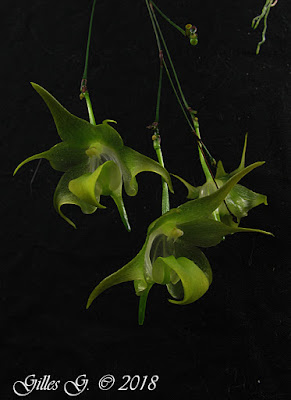Aeranthes neoperrieri is endemic to Madagascar, where it grows s in mossy, evergreen rainforest in the province of Toamasina at elevations of sea level to 499 meters above sea level.
Aeranthes neoperrieri also called as Perrier's New Aeranthes, is a species of the genus Aeranthes. This species was described by Toill.-Gen., Ursch & Bosser in 1960.
IDENTIFY AERANTHES NEOPERRIERI ORCHID PLANT
Aeranthes neoperrieri is endemic to Madagascar, where it grows s in mossy, evergreen rainforest in the province of Toamasina at elevations of sea level to 499 meters above sea level.
It is a small sized epiphyte with short stem carrying 9-10, oblong-linear, unequally or nearly equally and obtusely leaves.
Perrier's New Aeranthes blooms in October from slender, pendent, with 3 or 4 branches, 50-70 cm long inflorescence. The flowers are green with darker green spur and are 1.5 cm in diameter.
AERANTHES NEOPERRIERI ORCHID PLANT CARE AND CULTURE
Cultural information should only be used as a guide, and should be to be adapted to suit you. Your physical location; where you grow your plants, how much time you have to devote to their care, and many other factors, will need to be taken into account. Only then can you decide on the cultural methods that best suit you and your plants.
Light:
Aeranthes neoperrieri needs a light level of 12000-20000 lux. Light should be filtered or diffused, and plants should not be exposed to direct midday sun. Strong air movement should be provided at all times.
Temperature:
Summer days temperature at average 26-27°C, and nights temperature at average 16°C, with a diurnal range of 10-11°C.
Humidity:
Perrier's New Aeranthes need the humidity of near 85% most of the year, dropping to near 80% for 2-3 months in spring.
Substrate, growing media and repotting:
Aeranthes neoperrieri may be grown in shallow, well-drained containers or mounted on tree-fern slabs. Mounted plants need high humidity, however, and during hot, dry weather they may need several waterings a day.
If it is difficult to keep mounted plants moist enough, they may be grown in a shallow pot or basket filled with a very open, fast-draining medium that has excellent drainage, is well aerated, and allows the medium to dry fairly rapidly after watering.
Plants should be repotted immediately if the medium starts to break down as Aeranthes species are prone to rot if conditions around the roots become stale. Repotting should be done just as new roots start to grow. This enables the plant to become reestablished in the shortest possible time.
Watering:
Rainfall is very heavy most of the year. Amounts decrease somewhat for a month or so in spring, but the habitat is never truly dry. Cultivated plants should be watered heavily while actively growing, but conditions around the roots should never become stale or soggy.
Fertilizer:
1/4-1/2 recommended strength, applied weekly when plants are actively growing. You can use a balanced fertilizer throughout the year; but also can use a high-nitrogen fertilizer from spring to midsummer, then switch to one high in phosphates in late summer and autumn.
Rest period:
Growing conditions should be maintained all year, or winter days temperature at average 20-21°C, and nights average 9-10°C, with a diurnal range of 11-12°C. In winter, water should be reduced somewhat for Aeranthes neoperrieri, especially those grown in the dark, short-day conditions common in temperate latitudes. They should never be allowed to dry out completely, however. If water is reduced, fertilizer should also be reduced.















COMMENTS